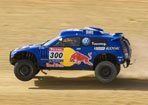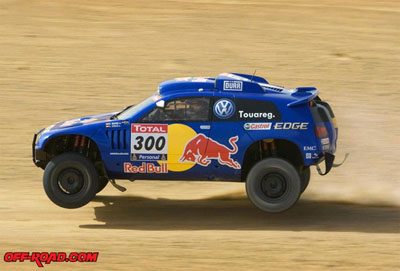 Volkswagen has unveiled its new Dakar challenger, the Race Touareg 3. Replacing the Race Touareg 2, twice winner in 2009 and 2010 of the grueling Dakar Rally and the first diesel-powered vehicle ever to win the event, the new Race Touareg 3 promises to be faster and more efficient while retaining the immense strength and durability of the outgoing car.
Volkswagen has unveiled its new Dakar challenger, the Race Touareg 3. Replacing the Race Touareg 2, twice winner in 2009 and 2010 of the grueling Dakar Rally and the first diesel-powered vehicle ever to win the event, the new Race Touareg 3 promises to be faster and more efficient while retaining the immense strength and durability of the outgoing car.
Off-Road.com regulars might remember that VW unveiled its race Touareg a few years back with a team of Ryan Arciero and Mark Miller set to tackle the SCORE Tecate Baja 1000. The Touareg had a few mechanical issues during the race and didn’t quite live up to expectations at the 1000, but it did fare better in the Dakar and looks to have continued success in 2011.
VW reported that wind tunnel testing led to changes being made to the carbon fiber and Kevlar bodywork, with particular attention to improving the cooling systems around the roof. The Touareg also gets an updated look with new LED lights, a new grille, window line, rear clamshell and wheels.
 Powering the new Touareg is a twin-turbocharged 2.5-litre TDI engine that produces 442 lb-ft of torque. With the severe altitude changes of the Dakar, with the vehicle climbing to heights of over 15,000 feet above sea level, the Race Touareg 3 has been adjusted to adapt to maintain high performance that can be compromised at the thinner air encountered at such altitudes. The 2.5-litre engine channels its drive through three limited slip differentials via a newly upgraded five-speed sequential gearbox and a ZF-Sachs three-plate ceramic clutch. VW says the Touareg can accelerate to 62 mph in 6.1 seconds before reaching a top speed of 117 mph.
Powering the new Touareg is a twin-turbocharged 2.5-litre TDI engine that produces 442 lb-ft of torque. With the severe altitude changes of the Dakar, with the vehicle climbing to heights of over 15,000 feet above sea level, the Race Touareg 3 has been adjusted to adapt to maintain high performance that can be compromised at the thinner air encountered at such altitudes. The 2.5-litre engine channels its drive through three limited slip differentials via a newly upgraded five-speed sequential gearbox and a ZF-Sachs three-plate ceramic clutch. VW says the Touareg can accelerate to 62 mph in 6.1 seconds before reaching a top speed of 117 mph.
To tackle the off-road terrain, the Race Touareg 3 is based on a high-strength steel spaceframe chassis with a pair of springs and damper units fitted to every corner. A set of specially developed BF Goodrich 235/85 R16 tires provide the grip.
Volkswagen says the new Race Touareg 3 has already undergone shakedown tests comprising 10,000 kilometers of simulated special stages ahead of the 2011 Dakar Rally. This equates to twice the length of the Rally itself.
Source: Volkswagen